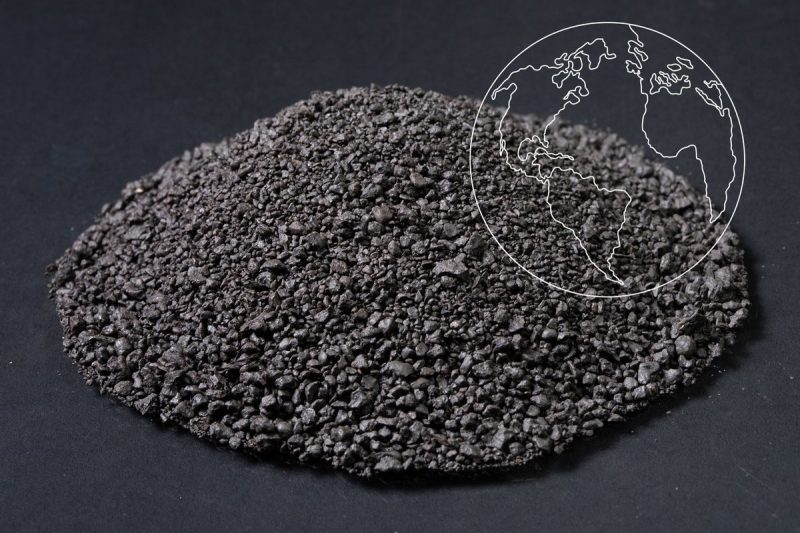Market volatility has become the norm for the top manganese-producing countries in recent years.
2022 was no different — manganese prices soared in the first half of the year after a sharp decline in supply brought on by challenging weather, COVID-19 restrictions in Australia and Russia’s war in Ukraine. Slowing demand in China, typically a hotbed for infrastructure projects, put the brakes on manganese prices in the second half of the year.
Looking forward, analysts expect increasing infrastructure activity and demand for steel to boost the manganese market in 2023 and beyond. The metal is strongly dependent on demand from China, which requires large amounts of electrolytic manganese to produce steel for construction. Interest in battery applications for manganese could also be a positive force moving into the future as the green energy transition progresses. Benchmark Mineral Intelligence projects that demand for manganese will increase by eight-fold over the next decade on rising demand for electric vehicle batteries.
What are the uses of manganese?
While the steel industry is the primary end user of manganese metal, consuming it as an alloy to enhance the strength and workability of the key construction material, manganese is also mixed with aluminum to manufacture tin cans.
Aside from that crucial application, manganese dioxide and manganese oxide are often used as cathode materials in the production of zinc-carbon and alkaline batteries. Additionally, after crude oil is refined, manganese may be used as an additive to help coat and protect a car’s engine.
And, as mentioned, one of the most promising uses of manganese is in the lithium-ion battery sector. The silvery metal is used to make lithium-nickel-manganese-cobalt oxide, which is known to improve energy loading and lifespan. Batteries using this mineral composition are in high demand from the electric vehicle sector.
As the manganese market continues to develop, it’s useful to know where the metal comes from. Interestingly, almost 38 percent of global manganese mineral reserves are found in South Africa, though many other countries are significant manganese producers with sizeable reserves.
1. South Africa
Mine production: 7.2 million MT
South Africa is the world’s largest producer of manganese by a long shot. In 2022, its manganese output was on par with the previous year. The country also holds the largest reserves of manganese at 640 million metric tons (MT).
South32 (ASX:S32,LSE:S32,OTC Pink:SHTLF) is a major presence in the South African manganese industry. The diversified miner also produces bauxite, alumina and thermal and metallurgical coal, as well as other in-demand minerals. South Africa Manganese, one of the company’s four operations in South Africa, is made up of Metalloys and Hotazel Manganese Mines. The Hotazel mine is located in the manganese-rich Kalahari Basin, which holds 80 percent of the world’s known manganese ore resources.
2. Gabon
Mine production: 4.6 million MT
Located on the central-western coast of Africa, Gabon was the second largest producer of manganese in 2022. The manganese-producing country was responsible for 4.6 million MT of manganese, a slight increase from the previous year’s 4.34 million MT.
Moanda is a key manganese operation in the country. ERAMET (EPA:ERA), the world’s second top producer of high-grade manganese ore, operates the mine through its subsidiary COMILOG. The August 2023 military coup in Gabon temporarily halted manganese-mining activities for ERAMET, but production has since resumed.
3. Australia
Mine production: 3.3 million MT
Australia’s manganese production was nearly flat in 2022 compared to the previous year’s 3.26 million MT. Though South32 is a key producer in the South African manganese sector, the company also has an Australian manganese operation.
As the largest producer of manganese ore, South32 has a 60 percent stake in a Northern Territory manganese mine, which it operates through its subsidiary Groote Eylandt Mining Company (GEMCO). The open-cut manganese mine is one of the world’s lowest-cost manganese ore producers. Anglo American (LSE:AAL,OTCQX:AAUKF) holds the other 40 percent interest in the project.
In addition to GEMCO, the miner operates Tasmanian Electro Metallurgical Company (TEMCO), as well as the TEMCO manganese alloy plant, which produces ferromanganese used for steel manufacturing.
4. China
Mine production: 990,000 MT
China was the fourth largest producer of manganese in 2022, recording output of 990,000 MT; that’s a sizeable decrease from the 1.34 million MT it produced in 2020. Much of this decline can be attributed to COVID-19-related disruptions.
As mentioned, the country is not only a player in manganese ore production, but also a major consumer of manganese as it uses large amounts of the metal in steelmaking.
Several large manganese deposits were reportedly discovered in Guizhou province in 2017, but have yet to be advanced. They are not counted by the US Geological Survey, which places China’s manganese reserves at 280,000 MT — the second largest globally.
5. Ghana
Mine production: 940,000 MT
Ghana’s 2022 manganese output weighed in at 940,000 MT, on par with what it produced in 2021. However, the country has stepped up its production of the metal in recent years, raising it from 2020’s number of 637,000 MT. Most manganese mined in Ghana comes from the western region around the city of Takoradi.
Consolidated Minerals, better known as Consmin, a subsidiary of Ningxia Tianyuan Manganese Industry (TMI), is one of the four largest producers of manganese in the world by volume and holds a 90 percent stake in Ghana Manganese Company, which runs the Nsuta mine. Manganese ore from the operation was traditionally destined for the electrolytic manganese metal market, much of it as captive supply for TMI’s China-based operations.
6. India
Mine production: 480,000 MT
In 2022, India was the sixth largest producer of manganese. The top manganese-producing country produced 480,000 MT of the metal, up from 2021’s 453,000 MT.
As with China and Brazil, India is one of the leaders in manganese consumption. The vast majority of India’s manganese goes to the production of steel.
Unfortunately, that could pose problems for India in the years to come — according to the Indian Ministry of Mines, the country is facing a shortage of manganese for steel production. In fact, its annual manganese mine supply has dropped significantly from 632,000 tonnes in 2020.
7. Brazil
Mine production: 400,000 MT
Brazil produced 400,000 MT of manganese in 2022, much lower than its output of 542,000 MT in 2021. Major miner Vale (NYSE:VALE) was previously the largest manganese miner in the country, accounting for 70 percent of the market. However, in 2022 the company offloaded its manganese and iron ore assets in Brazil to J&F Investimentos.
Now Buritirama Mining, a subsidiary of Grupo Buritipar, is the country’s largest manganese producer. The company plans to make a significant investment of US$200 million to expand operations at its Para state mine.
8. Ukraine
Mine production: 400,000 MT
Ukraine tied with Brazil as the seventh largest producer of manganese. The country’s 2022 output of 400,000 MT of the metal was a 200,000 MT decrease from 2021’s numbers. Russia’s war in Ukraine has no doubt had a negative impact. As with some of the other countries on the list, Ukraine is also a major importer of manganese products, specifically manganese ore.
The country is among the top five for largest reserves of manganese ore in the world, at 140 million MT. The country’s Nikopol basin holds about a third of the explored reserves. Ukraine also has significant iron ore, coal and titanium deposits.
9. Cote d’Ivoire
Mine production: 360,000 MT
The West African nation of Cote d’Ivoire put out 360,000 MT of manganese in 2022; that’s nearly on par with the 362,000 MT in the year prior. However, the 2022 figure is down from the 525,000 MT produced in 2020.
Cote d’Ivoire’s manganese exports make their way to steel-producing giant China.
10. Malaysia
Mine production: 360,000 MT
Malaysia rounds out the list of top manganese-producing countries, tying with Cote d’Ivoire with output out 360,000 MT of manganese in 2022; that’s a small increase from 356,000 MT produced in the previous year. The country recently emerged on the scene as a new hub for manganese ferroalloy production.
Malaysia’s manganese production accounts for 18 percent of US imports, as per the US Geological Survey. OM Sarawak, a subsidiary of Singapore-based manganese and silicon metals company OM Holdings (ASX:OMH,OTCQX:OMHI), owns a ferrosilicon and manganese alloy smelter in Malaysia. It has an output capacity of around 250,000 to 300,000 MT of manganese alloy per year.
Potential manganese deposits
There are a number of mining companies interested in the developing manganese resources, and others working in exploration to target new deposits. Mining for manganese is one way to recover the metal, and scouring the seafloor is another way to source this valuable construction and battery metal.
According to the London School of Economics, manganese nodules cover thousands of square kilometers on the ocean floor. The metal-bearing nodules are primarily composed of manganese; however, they also contain nickel, cobalt and copper, making them a potentially lucrative diversified mineral resource.
FAQs for manganese
Is manganese a metal?
Manganese is considered an important industrial metal. With the atomic number 25, it is a hard, brittle, silvery metal that is only second to iron among the transition elements in its abundance in Earth’s crust.
What function does manganese dioxide have in batteries?
Manganese dioxide has long been used as a depolarizer in alkaline batteries, but this is not the manganese battery market that is now the most interesting. Attention is being drawn to lithium-ion battery chemistries that require manganese — such as lithium-manganese oxide batteries and lithium-nickel-manganese-cobalt oxide batteries.
In these batteries, electrolytic manganese dioxide is used as a cathode material. Investors who believe battery sector demand for manganese will increase are optimistic that lithium-ion batteries that require manganese will become more common in the future.
Securities Disclosure: I, Melissa Pistilli, hold no direct investment interest in any company mentioned in this article.





























